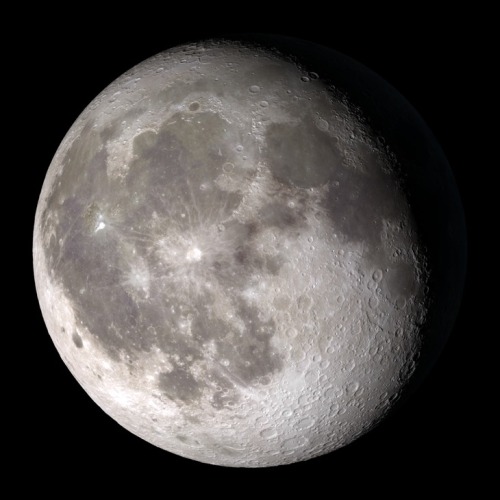Starsglaxiesspace - SPACE

More Posts from Starsglaxiesspace and Others

Sensor to monitor orbital debris outside space station
The International Space Station isn’t the only spacecraft orbiting the Earth. In fact, it is accompanied by the Hubble Space Telescope, satellites within the Earth Observing System, and more than 1,000 other operational spacecraft and CubeSats. In addition to spacecraft, bits of orbital debris - human-made objects no longer serving a purpose in space - are also in orbit.
With an estimated more than 100 million pieces of orbital debris measuring smaller than one centimeter currently in Earth’s orbit, they can be too small to track, but many are large enough to cause damage to operational spacecraft.
The space station has orbital debris shields in place to protect from debris less than 1.5 centimeters in size. Larger debris pieces are tracked by ground control, and if needed, the space station thrusters can be used to safely move station away from the debris.
The Space Debris Sensor (SDS) will monitor the small debris environment around the space station for two to three years, recording instances of debris between the sizes of .05mm to.5mm. Objects larger than 3 mm are monitored from the ground. It will launch to station in the trunk of a SpaceX Dragon during a resupply mission no earlier than Dec. 12.
Orbital debris as small as .3mm may pose a danger to human spaceflight and robotic missions.
“Debris this small has the potential to damage exposed thermal protection systems, spacesuits, windows and unshielded sensitive equipment,” said Joseph Hamilton, the project’s principal investigator. “On the space station, it can create sharp edges on handholds along the path of spacewalkers, which can also cause damage to the suits.”
Once it is mounted on the exterior of the Columbus module aboard the space station, the sensor will provide near-real-time impact detection and recording capabilities.
Using a three-layered acoustic system, the SDS characterizes the size, speed, direction and density of these small particles. The first two layers are meant to be penetrated by the debris. This dual-film system provides the time, location and speed of the debris, while the final layer - a Lexan backstop - provides the density of the object.
The first and second layers of the SDS are identical, equipped with acoustic sensors and .075mm wide resistive lines. If a piece of debris damages the first layer, it cuts through one or more of the resistive lines before impacting and going through the second layer. Finally, the debris hits the backstop plate.
Although the backstop won’t be used to return any of the collected samples, combined with the first two layers, it gives researchers valuable data about the debris that impacts the SDS while in orbit.
“The backstop has sensors to measure how hard it is hit to estimate the kinetic energy of the impacting object,” said Hamilton. “By combining this with velocity and size measurements from the first two layers, we hope to calculate the density of the object.”
The acoustic sensors within the first two layers measure the impact time and location using a simple triangulation algorithm. Finally, combining impact timing and location data provides impact and direction measurements of the debris.
Data gathered during the SDS investigation will help researchers map the entire orbital debris population and plan future sensors beyond the space station and low-Earth orbit, where the risk of damage from orbital debris is even higher to spacecraft.
“The orbital debris environment is constantly changing and needs to be continually monitored,” said Hamilton. “While the upper atmosphere causes debris in low orbits to decay, new launches and new events in space will add to the population.”









❤️😭😊😍

(ESA/Hubble) Hubble-X is a glowing gas cloud, one of the most active star-forming regions within galaxy NGC 6822. The name Hubble-X does not refer to the shape of the gas cloud, but rather is derived from a catalog of objects in this particular galaxy.
Credit: NASA/ESA and The Hubble Heritage Team (STScI/AURA)
About the Object Name: Barnard’s Galaxy, Hubble-X, NGC 6822 Type: Local Universe : Nebula : Type : Star Formation Local Universe : Galaxy : Type : Barred Local Universe : Galaxy : Type : Irregular Distance: 2 million light years ConstellatioSagittarius Category: Galaxies
Coordinates
Position (RA):19 45 5.03 Position (Dec): -14° 43’ 20.00" Field of view: 1.09 x 1.01 arcminutes Orientation: North is 305.8° left of vertical

Source


Jupiter’s Little Red Spot





Infraphylum Agnatha
Agnathans are a group of jawless fishes that include Myxini (hagfish) and Petromyzontidae (lampreys). Pictured above are Petromyzontidae, also known as lampreys. The name “lamprey” is derived from Latin meaning “stone licker.” The most well known lamprey species are a parasitic and feed by boring into the flesh of other fish to suck their blood. However there are a some species of lamprey that non-parasitic.
The Moon in Motion
Happy New Year! And happy supermoon! Tonight, the Moon will appear extra big and bright to welcome us into 2018 – about 6% bigger and 14% brighter than the average full Moon. And how do we know that? Well, each fall, our science visualizer Ernie Wright uses data from the Lunar Reconnaissance Orbiter (LRO) to render over a quarter of a million images of the Moon. He combines these images into an interactive visualization, Moon Phase and Libration, which depicts the Moon at every day and hour for the coming year.

Want to see what the Moon will look like on your birthday this year? Just put in the date, and even the hour (in Universal Time) you were born to see your birthday Moon.
Our Moon is quite dynamic. In addition to Moon phases, our Moon appears to get bigger and smaller throughout the year, and it wobbles! Or at least it looks that way to us on Earth. This wobbling is called libration, from the Latin for ‘balance scale’ (libra). Wright relies on LRO maps of the Moon and NASA orbit calculations to create the most accurate depiction of the 6 ways our Moon moves from our perspective.
1. Phases

The Moon phases we see on Earth are caused by the changing positions of the Earth and Moon relative to the Sun. The Sun always illuminates half of the Moon, but we see changing shapes as the Moon revolves around the Earth. Wright uses a software library called SPICE to calculate the position and orientation of the Moon and Earth at every moment of the year. With his visualization, you can input any day and time of the year and see what the Moon will look like!
2. Shape of the Moon

Check out that crater detail! The Moon is not a smooth sphere. It’s covered in mountains and valleys and thanks to LRO, we know the shape of the Moon better than any other celestial body in the universe. To get the most accurate depiction possible of where the sunlight falls on the lunar surface throughout the month, Wright uses the same graphics software used by Hollywood design studios, including Pixar, and a method called ‘raytracing’ to calculate the intricate patterns of light and shadow on the Moon’s surface, and he checks the accuracy of his renders against photographs of the Moon he takes through his own telescope.

3. Apparent Size

The Moon Phase and Libration visualization shows you the apparent size of the Moon. The Moon’s orbit is elliptical, instead of circular - so sometimes it is closer to the Earth and sometimes it is farther. You’ve probably heard the term “supermoon.” This describes a full Moon at or near perigee (the point when the Moon is closest to the Earth in its orbit). A supermoon can appear up to 14% bigger and brighter than a full Moon at apogee (the point when the Moon is farthest from the Earth in its orbit).
Our supermoon tonight is a full Moon very close to perigee, and will appear to be about 14% bigger than the July 27 full Moon, the smallest full Moon of 2018, occurring at apogee. Input those dates into the Moon Phase and Libration visualization to see this difference in apparent size!
4. East-West Libration
Over a month, the Moon appears to nod, twist, and roll. The east-west motion, called ‘libration in longitude’, is another effect of the Moon’s elliptical orbital path. As the Moon travels around the Earth, it goes faster or slower, depending on how close it is to the Earth. When the Moon gets close to the Earth, it speeds up thanks to an additional pull from Earth’s gravity. Then it slows down, when it’s farther from the Earth. While this speed in orbital motion changes, the rotational speed of the Moon stays constant.
This means that when the Moon moves faster around the Earth, the Moon itself doesn’t rotate quite enough to keep the same exact side facing us and we get to see a little more of the eastern side of the Moon. When the Moon moves more slowly around the Earth, its rotation gets a little ahead, and we see a bit more of its western side.
5. North-South Libration

The Moon also appears to nod, as if it were saying “yes,” a motion called ‘libration in latitude’. This is caused by the 5 degree tilt of the Moon’s orbit around the Earth. Sometimes the Moon is above the Earth’s northern hemisphere and sometimes it’s below the Earth’s southern hemisphere, and this lets us occasionally see slightly more of the northern or southern hemispheres of the Moon!
6. Axis Angle

Finally, the Moon appears to tilt back and forth like a metronome. The tilt of the Moon’s orbit contributes to this, but it’s mostly because of the 23.5 degree tilt of our own observing platform, the Earth. Imagine standing sideways on a ramp. Look left, and the ramp slopes up. Look right and the ramp slopes down.
Now look in front of you. The horizon will look higher on the right, lower on the left (try this by tilting your head left). But if you turn around, the horizon appears to tilt the opposite way (tilt your head to the right). The tilted platform of the Earth works the same way as we watch the Moon. Every two weeks we have to look in the opposite direction to see the Moon, and the ground beneath our feet is then tilted the opposite way as well.
So put this all together, and you get this:
Beautiful isn’t it? See if you can notice these phenomena when you observe the Moon. And keep coming back all year to check on the Moon’s changing appearance and help plan your observing sessions.
Follow @NASAMoon on Twitter to keep up with the latest lunar updates.
Make sure to follow us on Tumblr for your regular dose of space: http://nasa.tumblr.com.
https://instagram.com/p/BdFWP5XDApj/

Measuring Cosmic Rays at the Edge of Space

It’s a bird! It’s a plane! It’s a… SuperTIGER?
No, that’s not the latest superhero spinoff movie - it’s an instrument launching soon from Antarctica! It’ll float on a giant balloon above 99.5% of the Earth’s atmosphere, measuring tiny particles called cosmic rays.

Right now, we have a team of several scientists and technicians from Washington University in St. Louis and NASA at McMurdo Station in Antarctica preparing for the launch of the Super Trans-Iron Galactic Element Recorder, which is called SuperTIGER for short. This is the second flight of this instrument, which last launched in Antarctica in 2012 and circled the continent for a record-breaking 55 days.

SuperTIGER measures cosmic rays, which are itty-bitty pieces of atoms that are zinging through space at super-fast speeds up to nearly the speed of light. In particular, it studies galactic cosmic rays, which means they come from somewhere in our Milky Way galaxy, outside of our solar system.

Most cosmic rays are just an individual proton, the basic positively-charged building block of matter. But a rarer type of cosmic ray is a whole nucleus (or core) of an atom - a bundle of positively-charged protons and non-charged neutrons - that allows us to identify what element the cosmic ray is. Those rare cosmic-ray nuclei (that’s the plural of nucleus) can help us understand what happened many trillions of miles away to create this particle and send it speeding our way.

The cosmic rays we’re most interested in measuring with SuperTIGER are from elements heavier than iron, like copper and silver. These particles are created in some of the most dynamic and exciting events in the universe - such as exploding and colliding stars.

In fact, we’re especially interested in the cosmic rays created in the collision of two neutron stars, just like the event earlier this year that we saw through both light and gravitational waves. Adding the information from cosmic rays opens another window on these events, helping us understand more about how the material in the galaxy is created.
Why does SuperTIGER fly on a balloon?

While cosmic rays strike our planet harmlessly every day, most of them are blocked by the Earth’s atmosphere and magnetic field. That means that scientists have to get far above Earth - on a balloon or spacecraft - to measure an accurate sample of galactic cosmic rays. By flying on a balloon bigger than a football field, SuperTIGER can get to the edge of space to take these measurements.

It’ll float for weeks at over 120,000 feet, which is nearly four times higher than you might fly in a commercial airplane. At the end of the flight, the instrument will return safely to the ice on a huge parachute. The team can recover the payload from its landing site, bring it back to the United States, repair or make changes to it, if needed, and fly it again another year!

There are also cosmic ray instruments on our International Space Station, such as ISS-CREAM and CALET, which each started their development on a series of balloons launched from Antarctica. The SuperTIGER team hopes to eventually take measurements from space, too.
Why do we launch from Antarctica?

McMurdo Station is a hotspot for all sorts of science while it’s summer in the Southern Hemisphere (which is winter here in the United States), including scientific ballooning. The circular wind patterns around the pole usually keep the balloon from going out over the ocean, making it easier to land and recover the instrument later. And the 24-hour daylight in the Antarctic summer keeps the balloon at a nearly constant height to get very long flights - it would go up and down if it had to experience the temperature changes of day and night. All of that sunlight shining on the instrument’s array of solar cells also gives a continuous source of electricity to power everything.

Antarctica is an especially good place to fly a cosmic ray instrument like SuperTIGER. The Earth’s magnetic field blocks fewer cosmic rays at the poles, meaning that we can measure more particles as SuperTIGER circles around the South Pole than we would at NASA scientific ballooning sites closer to the Earth’s equator.

The SuperTIGER team is hard at work preparing for launch right now - and their launch window opens soon! Follow @NASABlueshift for updates and opportunities to interact with our scientists on the ice.
Make sure to follow us on Tumblr for your regular dose of space: http://nasa.tumblr.com.
-
 tngbabe liked this · 6 years ago
tngbabe liked this · 6 years ago -
 afterthedragonflies liked this · 6 years ago
afterthedragonflies liked this · 6 years ago -
 argle-bargling liked this · 6 years ago
argle-bargling liked this · 6 years ago -
 16fahri liked this · 6 years ago
16fahri liked this · 6 years ago -
 tyyiyi liked this · 6 years ago
tyyiyi liked this · 6 years ago -
 irate-pirate-bi-27 liked this · 6 years ago
irate-pirate-bi-27 liked this · 6 years ago -
 sunatdusk reblogged this · 6 years ago
sunatdusk reblogged this · 6 years ago -
 sharkspaceengine liked this · 6 years ago
sharkspaceengine liked this · 6 years ago -
 niavirrivain liked this · 6 years ago
niavirrivain liked this · 6 years ago -
 michael-rocket liked this · 6 years ago
michael-rocket liked this · 6 years ago -
 cannibaldotcom liked this · 6 years ago
cannibaldotcom liked this · 6 years ago -
 tonyequate liked this · 7 years ago
tonyequate liked this · 7 years ago -
 starsgivemehp reblogged this · 7 years ago
starsgivemehp reblogged this · 7 years ago -
 mylittlegoldenbook reblogged this · 7 years ago
mylittlegoldenbook reblogged this · 7 years ago -
 starsglaxiesspace reblogged this · 7 years ago
starsglaxiesspace reblogged this · 7 years ago -
 thedrowsydoormouse reblogged this · 7 years ago
thedrowsydoormouse reblogged this · 7 years ago -
 sixgunsong-blog liked this · 7 years ago
sixgunsong-blog liked this · 7 years ago -
 s-t-y-x liked this · 7 years ago
s-t-y-x liked this · 7 years ago -
 ecstahtical reblogged this · 7 years ago
ecstahtical reblogged this · 7 years ago -
 blue-1337-blog reblogged this · 7 years ago
blue-1337-blog reblogged this · 7 years ago -
 blue-1337-blog liked this · 7 years ago
blue-1337-blog liked this · 7 years ago -
 marciaianches-blog liked this · 7 years ago
marciaianches-blog liked this · 7 years ago -
 malauri-blog1 liked this · 7 years ago
malauri-blog1 liked this · 7 years ago -
 sonictundra944 liked this · 7 years ago
sonictundra944 liked this · 7 years ago -
 bunnisweet liked this · 7 years ago
bunnisweet liked this · 7 years ago -
 odannielxoxo79-blog liked this · 7 years ago
odannielxoxo79-blog liked this · 7 years ago -
 0710zeynep liked this · 7 years ago
0710zeynep liked this · 7 years ago -
 rinofwater liked this · 7 years ago
rinofwater liked this · 7 years ago -
 g-l-y-t liked this · 7 years ago
g-l-y-t liked this · 7 years ago -
 space108-blog liked this · 7 years ago
space108-blog liked this · 7 years ago -
 careful-knives reblogged this · 7 years ago
careful-knives reblogged this · 7 years ago -
 careful-knives liked this · 7 years ago
careful-knives liked this · 7 years ago -
 rattkinng liked this · 7 years ago
rattkinng liked this · 7 years ago -
 tumbimongo reblogged this · 7 years ago
tumbimongo reblogged this · 7 years ago -
 tumbimongo liked this · 7 years ago
tumbimongo liked this · 7 years ago -
 ttiredboi liked this · 7 years ago
ttiredboi liked this · 7 years ago